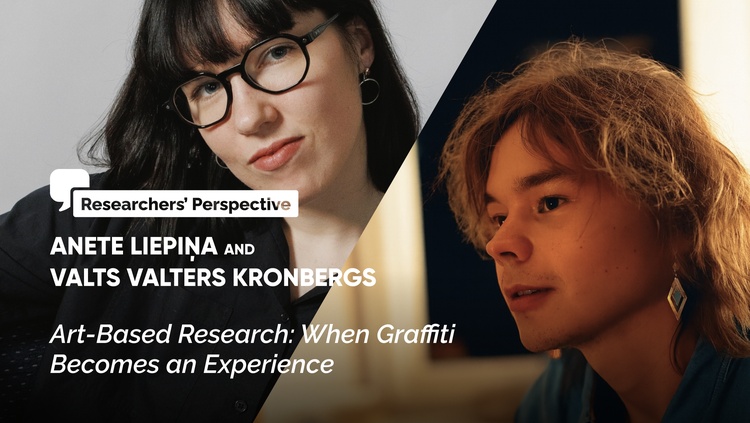
Art-Based Research: When Graffiti Becomes an Experience
By Anete Liepiņa and Valts Valters Kronbergs,
Bachelor students of “Sociology and Management of Culture” at the Latvian Academy of Culture
We are third-year students of “Sociology and Management of Culture” at the Latvian Academy of Culture and emerging researchers – research assistants at the LAC Institute of Arts and Cultural Studies. Our collaboration began within the study process, yet our research journey has evolved organically, as we increasingly came to understand contemporary art not only as an aesthetic experience but also as a social and educational phenomenon. This shared curiosity led us to the idea of developing “Graffito” – an art-based research project in continuous evolution.
A significant milestone on our path towards art-based research was our experience at the Latvian Centre for Contemporary Art, which helped us recognize the broad significance of contemporary art. Particularly formative was the 2024 Summer School “Language and Its Social and Political Contexts,” where we explored the various manifestations of language, emphasizing it as a social and communicative instrument across different social groups. Within this framework, we turned to the study and annotation of textual graffiti, analyzing their contexts of emergence and conceptually interpreting their content.
This experience demonstrated that art-based research enables access to questions that traditional methods often cannot fully capture. It revealed that language, visuality, and creativity can become powerful tools for studying specific social groups and communities, as well as the processes unfolding within them. From this experience, our interest in exploring the phenomenon of textual graffiti grew naturally.
The project’s development was also supported by the national research programme “Latvian Culture – a Resource for National Development,” specifically through the pilot programme “Testing Approaches to Measuring Social Impact” within the project “Cultural and Creative Ecosystem of Latvia as a Resource of Resilience and Sustainability” / CERS. This programme provided students with the opportunity to implement their own research ideas and receive funding for their development.
Graffiti are often perceived as the “background noise” of urban space, yet a research-driven perspective reveals an entirely different dimension. Within our project, we defined “graffito” as public drawings or scratchings on buildings, parks, and shared-space objects – excluding professional murals and commissioned artworks. Viewed this way, graffito becomes more than an urban phenomenon or form of youth self-expression: it can also be seen as a reflection of a community’s social environment, cultural consumption, and communication styles – even as a sign of belonging. This realization inspired us to ask a deeper question: how does graffito influence young people’s well-being?
The study applied art-based research methods, analyzing more than 400 graffiti found in Valmiera’s urban environment, examining their impact on youth well-being, and developing a series of theoretically and creatively grounded workshops for school students. Throughout the process, we explored young people’s perceptions of graffiti – how they understand it, why they choose to engage with it, or, conversely, why they reject it.
Why is research important here? Because only through research can we fully assess the significance and long-term value of what is happening. Art-based research allows one to be present and to reflect on processes from within. It differs from other methods in that the researcher becomes not merely an observer but an active participant. Such an approach demands responsibility, adaptability, and readiness to embrace challenges – especially as contemporary art often addresses controversial or sensitive topics. Researchers in such contexts must be prepared to engage with diverse opinions and conflicting reactions.
The implementation of “Graffito!” confirmed that these challenges do not become obstacles, but rather catalysts for learning new approaches. Working with young people, we developed the ability to foster dialogue, adapt, and convey the significance of our ideas – enhancing not only our academic skills but also our communication and collaboration capacities.
The enthusiasm of the students inspired us to involve artists Gundega Evelone and the creative collective “Poetic Robotism” (Eva Vēvere and Laura Prikule) in the project. Together with school classes, the artists integrated the theme of graffiti both into traditional learning contexts and into subjects rarely addressed in secondary education. Students gained new experiences and skills in working with emotions and social phenomena through creative expression and self-discovery. They created objects from unconventional materials, explored performance as a medium, and developed acting skills.
In the following stage, our research team, in collaboration with one of the student classes, conducted a process-based residency together with LAC researchers – environmental aesthetics scholar Kamilla Kūna and choreographer Laima Jaunzeme. During the residency, students deepened their understanding of performance art and co-created a performance later presented in collaboration with the Valmiera Youth and Children’s Theatre Institute.
In its concluding phase, the team – together with scientific assistants from the LAC Institute of Arts and Culture – will evaluate the integration of contemporary art practices into the educational process and the authenticity of young people’s participation. The study will analyze youth engagement strategies, their effectiveness, and collaborative models between students and pupils, artists and pupils – both within and beyond the educational environment – to ensure methodological sustainability.
In conclusion, we would like to emphasize that art-based research is not merely about writing or analysis. It is a living practice that unites creativity, critical thinking, and collaboration. The experience of “Graffito!” proves that research can become a bridge between young people, art, and society – revealing not only professionally significant themes but also deeply personal questions that inspire continued growth and exploration.
